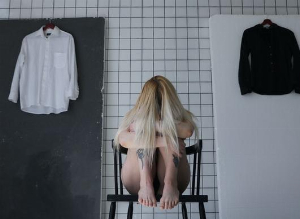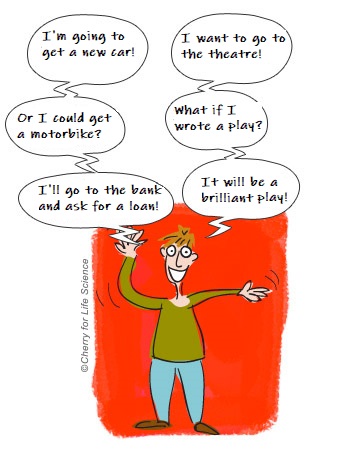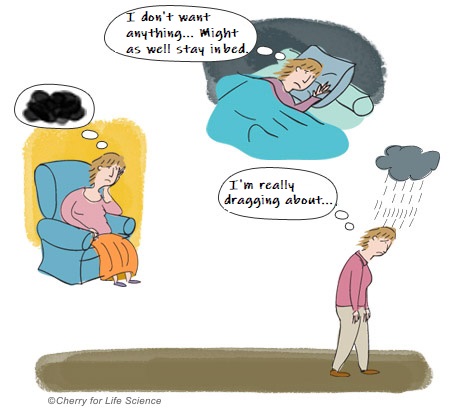Everything you need to know about bipolar disorder!
Published 9 Feb 2021 • By Candice Salomé
Bipolar disorder is a form of depression characterised by abnormal mood swing that alternate between depressive and manic episodes.
What are the symptoms of bipolar disorder? What are depressive and manic episodes? How is bipolar disorder diagnosed? Are there different forms of the condition? How is it treated?
We tell you everything in our article!

What is bipolar disorder?
Bipolar disorder, previously known as "manic depression", is one of a number of mood disorders such as clinical depression.
In its most typical form, bipolar disorder has two phases: the manic phase and the depressive phase. Between these two phases, the patient returns to a normal state (a symptom-free interval) called "euthymia".
What is a manic phase?
This phase is defined as an episode of pathological excitement. The patient is hyperactive, euphoric and has racing thoughts. He or she can present various behavioural disorders, lose his or her inhibitions or engage in reckless spending.

Source: Cherry for Life Science
The most common symptoms during a manic episode are:
- Insomnia: the patient barely sleeps at all but does not feel fatigue
- Mood swings: the patient experiences moments of intense euphoria and moments of irritability
- Heightened excitement: he or she experiences accelerated thoughts ("tachypsychia") and rapid speech ("logorrhoea")
- Hypersyntonia: this is hyper emotional reactivity; contact with others is familiar and easy, resulting in a, astonishing ability to detect and react to others' attitudes
- Hyperactivity: motor restlessness is significant.
- Megalomania: the patient encounters ideas of grandeur and overestimation of his or her own abilities and importance
What is a depressive phase?
This phase mirrors the manic phase. The patient shows signs of great sadness, loss of physical and mental energy and loss of interest in anything. Depending on the severity, patients in a depression episode can experience suicidal thoughts. The most severe forms are described as "melancholic," and are practically unable to feel pleasure in any form.

Source: Cherry for Life Science
The most common symptoms during a depressive episode are:
- General feeling of suffering: the patient's mental state is modified compared to the usual state,
- Feeling of hopelessness, sadness and emptiness: this is often accompanied by a general loss of interest and pleasure (anhedonia),
- Lack of energy and drive: this can make daily tasks seem insurmountable,
- Concentration and memory problems,
- Suicidal ideation is common,
- Sleep, appetite and libido are disrupted.
How is bipolar disorder diagnosed?
For patients suffering with bipolar disorder, a psychiatrist performs an initial medical check-up. Usually, he or she works in collaboration with other health professionals such as the GP, the occupational health physician or the school health physician.
This initial health check serves several purposes:
- To rule out illnesses with symptoms similar to bipolar disorder,
- To assess the severity of the bipolar disorder,
- To determine whether certain medications could have triggered the disorder,
- To check for an alcohol or drug addiction.
The psychiatrist therefore carries out a complete clinical evaluation by interviewing the patient and his or her family members about the symptoms and by retracing the history of manic and depressive episodes that have already occurred: their frequency, type, triggering factors, etc.
There are certain criteria that help in making the diagnosis, such as:
- Depression before the age of 25,
- Occurrence of at least 3 depressive episodes,
- Occurrence of at least one manic episode,
- Family history of bipolar disorder,
- Postpartum depression,
- Depression that did not respond or responds poorly to antidepressants,
- Occurrence of suicidal crises.
For 30% of patients, bipolar disorder appears during adolescence (between 18 and 24 years old). Women and men are equally affected. Bipolar disorder is diagnosed late, often 8 to 10 years after the onset of the illness.
Are there different types of bipolar disorder?
There are several classifications of bipolar disorder, the most common being:
- Bipolar I Disorder: a mental illness characterised by one or more episodes of mania. Most people with bipolar I have episodes of both mania and depression, but depressive episodes are not necessary for diagnosis. To be diagnosed with bipolar I, a patient's manic episodes must last at least seven days or be so severe that hospitalisation is necessary. This is the most common type of bipolar disorder.
- Bipolar II Disorder: this is a subtype of bipolar disorder in which patients experience alternating depressive episodes and hypomanic* episodes, but never a full manic episode.
- Cyclothymic Disorder (Cyclothymia): a chronically unstable mental state in which patients experience mild depression and hypomania for a period of at least two years. They may experience brief periods of normal mood, but they will often last for less than eight weeks.
- Bipolar Disorder, "other specified" and "unspecified": these classifications are used with a patient does not meet the diagnosis criteria for bipolar I, II or cyclothymic disorder but still experiences periods of significant and abnormal mood elevation.
These phases vary in intensity, duration and frequency from person to person. The duration of episodes and the time between each episode can range from a few days to months or even years.
The phases of bipolar disorder can occur in different ways:
- Classic sequence of type I and II disorder: hypomania/mania - depression - symptom-free interval
- Circular: phases come after one another without symptom-free interval between them
- Indefinite: the frequency is indefinite and the succession is impossible to predict.
*Hypomania is a lighter form of mania and often goes untreated, the symptoms being limited to physical and mental hyperactivity and sleep disturbance.
How is bipolar disorder treated?
In case of bipolar disorder, mood stabilising treatment is prescribed to the patient. These long-term treatments reduce the symptoms and prevent relapses.
Generally, these treatments are offered from the third episode of bipolar disorder onwards. However, if the first episodes have had serious social and/or professional consequences, they can be prescribed earlier.
There are different kinds of mood-stabilising treatments. Since the 1980s, one of the most widely used is lithium. In case of intolerance to this treatment, other mood stabilisers can be prescribed:
- Medication also used for nervous system disorders (anti-epileptics: carbamazepine, Depakote®, etc.)
- Medication also used for other psychiatric conditions (olanzapine, risperidone, aripiprazole, etc.).
If lithium is taken, the patient must undergo regular blood tests to monitor the amount of lithium in the blood in order to avoid certain side effects (trembling, drowsiness, nausea, weight gain, etc.) induced by too high doses. To check the treatment tolerance, the patient will also have to regularly undergo other tests, such as further blood tests and monitoring of both the heart thyroid gland.
In order to avoid any recurrence, treatment must be taken for a prolonged period of time (sometimes for life). However, treatment can be stopped when the patient's mood has been perfectly stabilised for at least two years. This must be done only following the GP or psychiatrist's guidance and under strict medical supervision.
Was this article helpful to you?
Share your thoughts and questions with the community in the comments below!
Take care!
Sources:
- Bipolar disorder, National Alliance on Mental Illness
- Le diagnostic, le bilan initial et l’évolution du trouble bipolaire, Ameli.fr
- Nature des troubles bipolaires, Troubles bipolaires
- Le traitement du trouble bipolaire, Ameli.fr
- Les troubles bipolaires, Fédération de la recherche pour le cerveau

 Facebook
Facebook Twitter
Twitter


